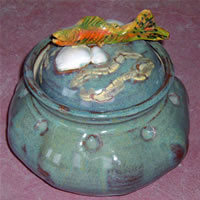
Collette Webster |
As I wander through the private yard
of Collette Webster’s new pottery studio, weaving
my way through tiles, teapots and basins, I am enchanted.
This garden is currently the repository for Webster’s
clay creations that haven’t met her expectations.
In one area, an oversized bowl that was once meant to be
used as a sink now serves as a birdbath. A glossy monarch
butterfly who will never beat or lose his wings graces
the basin’s ledge among scattered leaves that will
never blow away. One of these immortalized leaves has curled
slightly and detached itself from the basin, leaving the
sink porous (pun intended), which is why it sits in this
back yard, a resting place for the remains of the clay.
All around this private haven insects, butterflies and
lizards peer out, forever frozen in a look of natural repose
or alertness. They are a testament to Webster’s love
of natural motifs in her pottery and to her talent at rendering
these creatures in artistic and realistic fashion.
I have to watch where I place my feet since part of the
path is inlaid with a fabulous scene depicting an Asian-styled
golden-throated heron with blue-tipped wings soaring through
delicate clouds and a rabbit peering out from a wheat field.
These pieces were intended as a mural mosaic that didn’t
accommodate the thickness of glue needed to support its
weight. So despite hours of measuring, sculpting, firing
and glazing, this mural now graces a dirt path.

Keg |
This resting place for fabulous pottery
that cannot be used for its original intentions is a wondrous
testament that working with clay can be a metaphor for living
a zen life: find beauty wherever it lies, enjoy the process
and don’t get too attached to the results.
It’s only been six years since Webster discovered a
penchant and talent for pottery in a community class in Leadville,
Colorado. She can readily attest to the frustrations of this
art form. Despite the time and care invested in a piece,
there is no guarantee that the chemistry involved will perform
in an expected way. Hours and hours of sculpting, carving,
glazing, and so forth can seem for nought when the clay inexplicably
cracks in its final firing.
The majority of Webster’s work succeeds and you can
imagine how fabulous the shelf displaying her wares on the
inside of her new studio/gallery is when the outtakes out
back are so stunning.
Webster wows with the variety of forms she gives her earthenware.
The unifying element is nature, particularly birds, butterflies
and flowers. That is not to say that her pottery is trite
or frilly, although that might be a feat on its own. On her
bowls, cups and sundry pots, Webster recreates nature as
its seen, not sentimentalized.
The fauna she carves or sculpts looks like little creatures
caught in amber, forever frozen in a moment of everyday life.
A school of minnow-like fish encircle a particularly large
sconce. Webster has captured the density of the school and
its movement, which imbues life to the baked clay.
Webster’s petite frame belies her strength. Normally,
I don’t see any point in describing an artist’s
physique. After all, she is the artist, not the art. But,
pottery demands a physical performance. The large scale works
Webster produces require strong arms.

Fish School |
If the potter does not master the clay,
the clay masters the potter. Anyone who has experimented
with using the wheel for the first time will understand why
it’s called “throwing” since the unruly
mass of spinning dirt has a tendency to fling the inexperienced
potter about. It takes strength and skill to center a ball
of heavy wet clay.
Webster possesses both in spades. She creates 5-gallon water
jugs, floor lamps, basins and her current chef d’oeuvre,
a magnificent fountain.
Once on its base, the fountain should
stand about four feet high. The sculpture is created in the
image of a Mother Earth, with a rounded torso and a head
whose delicate features evoke a female. She looks benevolently
down towards hands that emerge from the globular body, around
which insects, dragonflies and frogs frolic.
This maternal image that gives forth water is as close to
a self-portrait as I can imagine in clay. Webster, a former
baker and caterer, has simply rerouted her nurturing side
from giving people something to eat to giving them something
to eat it on. She describes her creative side as “I
still have to feed people.”

Plate |
At the time that I saw this fountain
that will eventually grace the front of Webster’s studio
it had undergone its first firing from greenware, raw clay,
to bisqueware, baked clay. It was awaiting its second firing,
in which all the dull glazes magically transform under a
2100 degree temperature to brilliant colors and glosses.
Part of the craft of a potter is anticipating the chemical
reactions of the clay and various slips, underglazes, glazes
and oxides that can be used to decorate pottery. Much imagination
is required in believing that red will turn black, pink will
turn violette, brown can turn brilliant blue, and so forth.
Therein lies the crux, however. How do
you imagine the final outcome without getting too attached?
There is something fitting in having the remains of the clay
displayed in the back yard, a dust-to-dust metaphor. This
idea implies something deep and benevolent for Webster as
the one who carefully molds wet earth into beautiful, colorful
and recognizable shapes, bakes them and loves them no matter
their faults, literal and figurative. Once she has given
life to clay, she values it as a creator should, even as
she focuses on new pottery, exploring the endless possibilities
her inspiration and skill provide.
Collette Webster’s Studio/Gallery is located at 225
South 400 East, and she can be reached at (435) 220-0166.
The Gallery opening is scheduled for mid to late April. Commissions
available.

Collage |

Fish |
|





